Things to consider before buying the best banjo ukulele
We’ve reviewed eight of the finest banjo ukes out there and have given you some qualities about each. But, there are still lots of other things you need to know about banjoleles. You have to decide which type of the banjo uke you prefer to play, what kind of materials you feel are comfortable, your preference for design, and other pertinent things like whether it comes with additional accessories. Sometimes, these considerations can be determining when it comes to buying your banjolele.
 Banjolele type
Banjolele type
In our review of the eight best banjo ukuleles, we found them to be mostly concert banjoleles except for one tenor, the BanjoUke SideKick Tenor Banjolele. Generally, there is not a big difference between the concert and tenor banjolele types.
The first distinction you’ll notice right away is that the tenor is longer than the concert type. As such, its fretboard is noticeably bigger, which should make it slightly easier to play.
The longer size of the tenor also means that you’ll get more bass and volume than from the concert.
A tenor banjolele type is a good choice for novice learners or anyone that may have bigger fingers, or who just prefer the extra space. You’ll get better sound quality, and there’s more room for mistakes when playing it.
Construction
Like anything you buy, the materials used to create the product is a big factor in determining which one to buy. In an ideal world, you would want to find a banjolele that is made of the finest products at the lowest possible price. While that is not an easy task, we do see many similarities between the materials used to construct banjoleles.
Since banjoleles are a hybrid between the body of a banjo and the neck of a ukulele, the body itself very much resembles the wood construction of a banjo. Woods most commonly used in a banjolele construction include maple, rosewood, and mahogany. It is often accompanied by metal parts that help to add stability to the design. The heads are usually composed of polyester, sapele and some polyvinyl materials, while the fretboard can be made of rosewood and walnut.
We really loved the Oscar Schmidt OUB1 Banjolele for its mahogany construction that provides impressive quality of the sound.
Design
What’s great about some of these banjoleles is that they have their own unique personality and style. Many of them come from paying homage to their roots, while others just tend to incorporate a more neutral and classy design. Whatever it is, you can see for yourself the range of designs and determine which one suits your style the best.
Among the ones we reviewed that displayed a creative flair, the Luna Banjolele 8 Inch Ulu Design just might be the best one. This banjo uke shows a beautiful Hawaiian quilt design whose inspiration draws all the way back to the early 1800’s! Another great example is the BanjoUke SideKick Tenor Banjolele. It features a lovely Polynesian tattoo – another tribute paid this time to French Polynesia, where the ukulele is frequently played.
The banjolele with the most out-of-the-box choices of colors is the Gold Tone Little Gem Banjo Ukulele. This model features gem colors such as purple, blue, clear, and ruby red. This model is great for children who want to learn to play the banjolele and want a design that will really stand out.
 Number of frets
Number of frets
For those who don’t know, frets are the number of metal strips on a banjolele’s fretboard or neck. It is common for banjo ukulele to have 18 frets just as we can see with the Oscar Schmidt OUB1 Banjolele.
Having more frets, however, doesn’t necessarily mean it’s a good or better thing to have. It really comes down to which banjolele feels most comfortable in your hands. What we mean by this is that in the shorter (in length), concert-style banjoleles, the frets are closer together by virtue of their neck being shorter. For the longer, tenor style banjo ukes, the neck is longer, and thus, there is a bit more space between the frets.
Having more space between the frets gives players more space to finger their chords, therefore making the instrument more beginner-friendly.
However, having more space is not necessarily what players look for when buying a banjolele as many of them enjoy the shorter scale that a concert style one provides. As you can see, it really comes down to personal preference.
Strings
Nowadays, you can find different types of strings available on the market. The most popular are nylon strings or synthetic nylgut strings. One of the premier brands of quality strings is Aquila, and you know you have some solid strings if your banjolele comes with this brand. They produce the aforementioned nylgut strings, and many of the contemporary banjoleles come with them. Some perfect examples here are the Deering Goodtime Banjo Concert Scale Ukulele and the BanjoUke SideKick Tenor Banjolele.
Just like the strings on a guitar, you’ll need to fine-tune them until they’ve finished stretching.
Overall, the strings for banjoleles are strong, but like anything that has heavy wear and tear, strings are bound to break. Thus, it’s important to always have some spare ones at hand in case this happens.
Warranty
As we’ve seen from the eight best banjo ukuleles, the warranties for each product vary greatly. Banjoleles like the Oscar Schmidt OUB1 Banjolele and Luna Banjolele 8 Inch Ulu Design offer amazing lifetime warranties while on the opposite end of the spectrum, some manufacturers only provide you with a 30-day warranty. While there are certain conditions that need to be met in order to take advantage of the lifetime warranty, having this feature in your back pocket is a definite advantage in the event that something happens down the road to your banjolele.
Additional accessories

Replay Guitar Exchange, Tampa, FL, www.ReplayGuitar.com
In terms of additional accessories, such as a tuner, gig bag, and tools you may need, some banjoleles come with them while the rest don’t.
Let’s start with a gig bag. This can be a good accessory to have because it’ll help you transport your banjolele to different places. These bags, however, are not all the same as some come with padding to protect your banjolele. That’s why we particularly like that the BanjoUke SideKick Tenor Banjolele comes with a padded gig bag.
As for electronic tuners, it’s great to have it to spend less time figuring out how to make your instrument sound properly.
Every banjo uke package is different, and they all include different accessories, so it’s always best to double-check to see what exactly you’re getting aside from a great banjo ukulele.
Price range
Much like with any products, you’re going to find a wide range of prices, and that’s no different with these banjoleles. You should determine how much you’re willing to spend on a banjolele. We’ve made it easier for you and created three categories of pricing to give you an idea of how much you can expect to spend in each category.
In the lower-tier of pricing for banjoleles, one can reasonably expect to pay under $125. In this category, you’ll find the Kmise Banjolele 4 String and the Vangoa Concert Banjo Ukulele. These banjoleles are great for new players and people that are hesitant to pay top dollar for a hobby they may or may not take up long-term.
In the middle-tier pricing, you’ll find banjoleles in the $125-$300 range. The Oscar Schmidt OUB1 Banjolele and the Luna Banjolele 8 Inch Ulu Design fall into this category. In this range, you’ll notice an increase in the quality of materials of these banjoleles.
In the higher-end scale of pricing, $300 and above, premium banjoleles, made of the highest-quality materials, live in this category. You’ll find the Deering Goodtime Banjo Concert Scale Ukulele and Gold Tone Banjolele-DLX here.









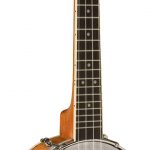





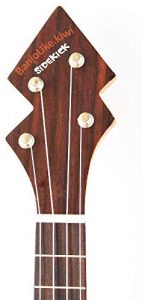












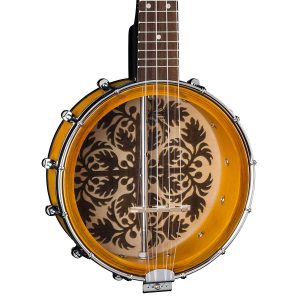
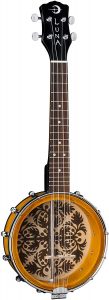












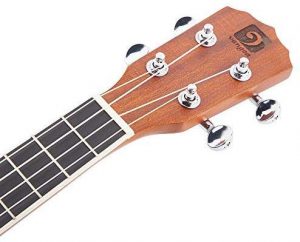


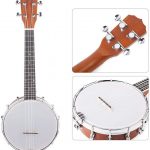





























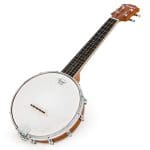







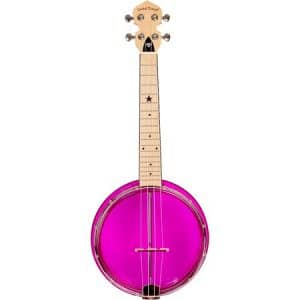

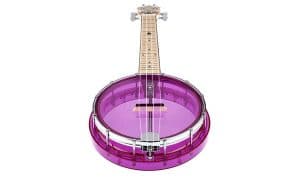




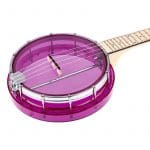
 Banjolele type
Banjolele type Number of frets
Number of frets










